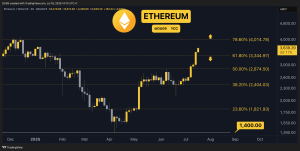Parachain auctions play a crucial role on Polkadot and Kusama. Their outcome determines which project is allotted a parachain slot and the number of tokens locked.
Both Polkadot and Kusama use candle auctions to allocate parachain slots. Candle auctions are a variant of open auctions in which participants put in increasingly higher bids, with the highest bidder declared the winner at the conclusion of the auction.
Understanding Candle Auctions
Candle auctions were first used in the 16th century for the sale of ships, and the name is derived from the system used to determine the auction length, with the phrase “inch of a candle” referring to the time required for the candle to burn 1 inch. When the candle is extinguished, the auction is concluded, and the current bid is declared the winner. Online candle auctions work differently. When used online, candle auctions require a random number to decide the moment of the auction’s conclusion. When it comes to parachain slot auctions, there is a slight difference because the auction is not terminated randomly. Instead, the auctions run for a fixed duration, with the winner randomly chosen retroactively.
How Do Candle Auctions On Polkadot Work?
Candle auctions on Polkadot are split into two parts: The opening period and the ending period.
The Opening Period
The opening period begins immediately after the start of the auction and lasts for one day and eighteen hours. This period functions as a buffer, allowing parachains to set up their initial bids, work on, and execute their strategy to win the slot auction. Polkadot will continue to accept bids during the opening phase, although they will not impact the outcome of the slot auction.
The Ending Period
The ending period lasts five days and follows the conclusion of the opening period. The auction is subject to end during the ending period based on the candle auction mechanism.
The Role Of VRF
The auction can end at any time during the ending period. The time to end the auction is randomly and automatically chosen by the Verifiable Random Function (VRF). The probability of participants winning the auction is equal to the number of blocks containing the winning bid, then divided by the total number of blocks in the ending period. Polkadot manages the random ending by propagating through the ending period, taking snapshots at each block within the ending period to capture the winners for a particular block. When the auction concludes, one of the snapshots is randomly chosen as the winner.
Parachain auctions on Polkadot last one week from beginning to end. The starting period lasts one day and 18 hours, while the ending period lasts five days. The remaining six hours are utilized to determine the winner.
Why Use Candle Auctions?
Candle auctions help address two main issues faced by blockchain-based auctions: Front running and the use of smart contracts among bidders. Front-running opportunities are common on blockchains because details of upcoming transactions can become common knowledge among network participants even before they are included in new blocks. In a blockchain auction, some bidders can see other bids and adjust their strategy even before they are recorded on-chain.
Meanwhile, smart contract bidders face problems with transparency. If the smart contract’s valuation is known in advance, the auctioneer could register their own bidder and place shill bids. This is a significant problem faced by second-price auctions.
Disclaimer: This article is provided for informational purposes only. It is not offered or intended to be used as legal, tax, investment, financial, or other advice.





















